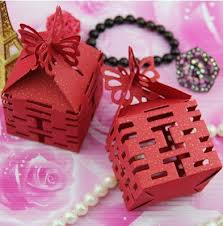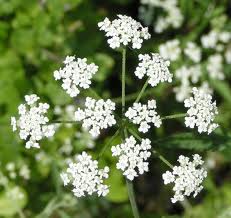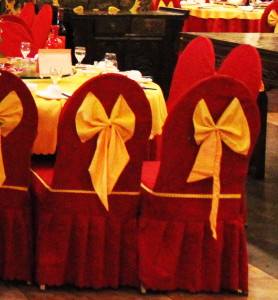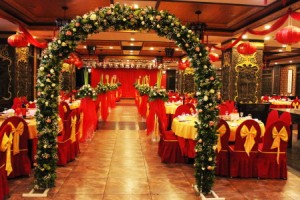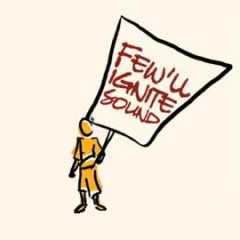Do Red & Pink Match?
Today is “Chinese New Year’s Eve” day and the red decorations are everywhere. I happen to be in the same city where we had our most formal wedding celebration (Zibo 淄博) and, thus, I have been thinking back to the wedding day decor. Like Chinese New Year, red is an important colour at Chinese weddings. Red lanterns are hung and, at both events, red envelopes or 红包 are passed around, not to mention the colour of the bride’s dress. This blog not only discusses colour, however; it is a glimpse at aesthetic differences between East and West. Enjoy!
**********************************************************
Two days before the big event in Shandong 山东—the main wedding that was fully organized by his parents (or should I say, his mother)—I was shuffled upstairs to the “wedding shop” and told to sit on a stool and wait. My parents were already with us in Zibo and they were waiting downstairs, outdoors on a beautiful fall day. The place was filled with larger-than-life catalogues and there were a few young couples being served. This was the company employed to organize our wedding.
Now, for a queer woman who had never planned on marriage, it was quite a shock to be introduced to the wedding planning industry with its prefab, factory-style efficiency, right then and there two days before the event! The running total number of weddings the company had organized was posted above their main counter. It was already well over 30,000. I asked a passing employee how long the company had been open. “不到三年 (Not quite three years)” she said, and she couldn’t have been a minute older than nineteen. I doubted she was married. I suddenly just felt like a statistic.
I was brought a paper cup of hot water, as per the polite way to greet a guest in China, and then they pointed to two large laminated books and asked me to pick out the following from a series of stock choices:
- the colour of the backdrop on the “stage” (I had no idea there’d be a stage!)
- the look and flavour of the cake (no one had chosen it yet?)
- the colour and type of the flowers (neither Queen Anne’s Lace nor Dandelions were among the choices!)
I was in shock. As I mentioned in this previous blog, my involvement in this event could be likened to the star female lead in someone else’s production. Here I was seated in the production company’s office and my MIL was the director. I was simply meant to come onto the scene at the sound of my cue. Since surrendering my control of the event was something I had been expected to do, I couldn’t understand why I was suddenly being asked my opinion about these things? What’s more, having such major details like décor, cake, and flowers still undecided two days before the event gave me a wash of panic. Could it possibly be this disorganized?
I asked my friend Cheryl to fetch my parents knowing this process would take more than a few minutes. Everyone came upstairs to wait while I thumbed through my options. The catalogues were enormous. Like a Chinese clothing market in which one has to browse past fifty shops before finding a vendor selling clothes you could possibly put on your body, I had to flip page after page in search of anything that wasn’t gaudy or over-the-top. Eventually, I started marking pages with “choices I could live with,” even if they were just a few notches above awful. That’s called being forced to make a choice in the midst of aesthetic displeasure.
The woman who was assigned to us clutched a clipboard and a pen. She was waiting for my decree. I grew more and more irritable with every flip of the page and began to wonder if I shouldn’t just give up, let them make any random choice, and just get out of there. I almost did just that. I took several deep breaths and saw it through.
In China, people wear prom dresses to the supermarket and sweat suits to weddings. I’m serious. Not everyone, of course, but it happens often enough to not be unusual. Colour and style seem to occupy quite different dimensions here than they do in North America. What’s more, inundated with Chinese aesthetics can lead to taste confusion; after several years here, sometimes I’m not sure if clothing that catches my eye is particularly stylish or heinously hideous!
For instance, the backdrop options were all intense colours with mixtures of gold, pink and red. They were fabrics lacking subtlety or class. Some even had cartoons on them! “Don’t you just have a plain black one?” I asked. After all, we’d show up better against it, I thought. Black was out of the question, they said, but they did have a plain red one they could use that wasn’t in the catalogue. I chose that one.
The cakes were all monstrosities of colour and fluffy icing with little wee statues of brides and grooms on the top that didn’t look anything like we did: the white-skinned, blond Western woman standing beside the dreadlocked Chinese man. On the very last page, I found a plain white cake iced like it was decorated with pearls. I asked for that one without the ornamental couple on top. They agreed. Another assault of colour avoided.
Finally, the flowers were for the archway we’d walk through and some displays around the tables. I requested just red and white ones. Turned out that roses and carnations were my only choices. I suggested both. Then the clipboard had its ticks and special notes in place and we were free to go. As we were walking out, I asked Guo Jian why he hadn’t chimed in with his opinion. He said, “Because I really don’t care.” I was suddenly envious.
Two days later on the day of the event, just before our meet and greet began at the entrance way to the banquet hall, I sneaked up to see what had happened with the space. To my horror, I found the tables were each decorated with a “French’s mustard” yellow tablecloth flanked by chairs with red covered backs adorned with huge gold bows as though people would be sitting on those supermarket prom dresses I mentioned earlier. Each table’s place settings appeared to have been vomited from a 1980’s McDonald’s restaurant colour scheme.
The plain red backdrop was in place behind the stage, but the flowers were scattered around the room in pink and white, as opposed to my request for red and white. This is when it finally hit home that “red” in Chinese is not a specific enough colour. Red or 红色 (hóngsè) is considered a family of colours of which pink is part. Pink or 粉红色 (fěnhóngsè-literally “powder red”) is different from bright red 大红色 (dàhóngsè-literally “big red”) and so on. I was brought up to see pink and red as clashing colours; to Chinese eyes, they match. Since I had only said “hóngsè 红色,” they were not wrong in choosing pink. Both my inferior language skills and our cultural differences were to blame for what was now a shocking colour combination: pink, red, white and the unfortunate yellow.
I could only laugh. Even though this tacky décor would forever be burned into my brain as the backdrop to my wedding day, it was funny. The three details given to me to choose at the last minute were outnumbered by a series of other aesthetic choices I would never have agreed to. I had to remind myself that this was a performance. Every show needs a set. I was only the female lead, not the set designer. I returned to the doorway and took up my post as a smiling bride offering my greetings.
From that moment onwards, in Chinese especially, I’ve always specified my reds.






